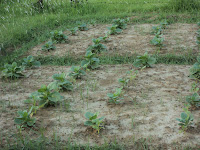At first ,i will show you the classification of vegetable based on growing season.
1.summer/rainy season vegetable-(cucurbits,cowpea,hyacinth bean,amaranth,aroid,,indian spinach etc)
2.winter season vegetable-(tomato,cabbage, chinese cabbage,cauliflower,eggplant,bottle gourd,radish etc)
3.All season vegetable-(crops like okra,heat tolerant tomato,eggplant,carrot,spinach,many leafy vegetable,small onion,etc) ( Radish ;from net)
Vegetables are classified according to which part of
the plant is eaten.
Leafy Vegetables
The plants whose edible parts are the leaves. They
are valued because of their mineral and salts content. They are juicy in nature
and are sometimes also calledsucculent vegetables.some leafy vegetables are given below. 

Amaranth (Amaranthus cruentus)
- Bitterleaf (Vernonia calvoana)
- Broccoli (Brassica oleracea Italica group)
- Brussels sprout (Brassica oleracea Gemmifera group)
- Cabbage (Brassica oleracea Capitata group)
- Cauliflower (Brassica oleracea Botrytis group)
- Chrysanthemum
- Lettuce (Lactuca sativa)
- Mustard (Sinapis spp)
- Spinach (Spinacia oleracea)
Fruit and flower vegetables
The plants whose edible parts are the fruits and the
flowers, they are fruits or buds of flowers in reality but are used as
vegetables. Vegetable fruits are fleshy and contain seeds. They present great
variety in appearance, structure, and composition. They are
(Avocado;from internet)
(Avocado;from internet)
- Avocado (Persea americana)
- Chile pepper (Capsicum annuum Longum group)
- Cucumber (Cucumis sativus)
- Eggplant or Aubergine (Solanum melongena)
- Olive (Olea europaea)
- Perennial cucumber (Coccinia grandis)
- Pumpkin (Cucurbita maxima, Cucurbita pepo)
- Snake gourd (Trichosanthes cucumerina)
- Sweet pepper (Capsicum annuum Grossum group)
- Tomato (Lycopersicon esculentum)
- Winter melon (Benincasa hispida)
Root, Tuber and Bulb vegetables:
The varieties included in this class are closely related as
to food value.
Bulbs are Usually grow just below the surface of the ground and produce
a fleshy, leafy shoot above ground. Bulbs usually consist of layers or
clustered segments. E.g. Onion, Garlic.
Tubers are vegetables which grow underground on the root of a plant.
E.g. Sweet potatoes, beets, radishes.
Roots are a long or round-shaped taproot.
- Asparagus (Asparagus officinalis)
- Garlic (Allium sativum)
- Onion (Allium cepa)
- Carrot (Daucus carota)
- Cassava (Manihot esculenta)
- Chinese artichoke (Stachys affinis)
-
Ginger (Zingiber officinale)
- Potato (Solanum tuberosum)
- Radish (Raphanus sativus)
- Sweet potato (Ipomoea batatas)
- Taro (Colocasia spp.)
- Turnip (Brassica rapa Rapifera group)
Podded vegetables
 They include all the varieties of beans, peas, and
lentils. When these foods are mature and dried, they have the highest food
value of all the vegetables
They include all the varieties of beans, peas, and
lentils. When these foods are mature and dried, they have the highest food
value of all the vegetables- Broad bean (Vicia faba)
- Chickpea (Cicer arietinum)
- Drumstick (Moringa oleifera)
- Fava bean (Vicia faba)
- French bean (Phaseolus vulgaris)
- Indian pea (Lathyrus sativus)
- Lentil (Lens culinaris)
- Mung bean (Vigna radiata)
- Okra (Abelmoschus esculentus)
- Pea (Pisum sativum)
- Peanut (Arachis hypogaea)
- Pigeon pea (Cajanus cajan)
- Rice bean (Vigna umbellatta)
- Runner bean (Phaseolus coccineus)
- Soybean (Glycine max)
- Sweetcorn (Zea mays)
-
Yardlong bean (Vigna unguiculata subsp. sesquipedalis)
(Drumstick)
Seaweed vegetables
The Sea contains, in solution, every element
necessary to maintain healthy life. Therefore, Seaweed offers a wealth of
essential nutrients found in human blood serum including vitamins, minerals,
enzymes, amino acids and fatty acids.
- Nori (Porphyra spp.)
- Ogonori (Gracilaria spp.)
- Sea grape (Caulerpa spp.)
- Sea lettuce (Ulva lactuca)
- Wakame (Undaria pinnatifida)
Cultural Classifications
For the grower this is probability the most
practical system of classification as it is based on essential methods of
culture. That is if a crop has similar climatic requirements and cultivation
requirements then they are group together. This grouping can does often mean
that crops group under the same heading may be botanically divergent. Perennial vegetables –
asparagus, rhubarb, artichoke
- Greens – Spinach, mustard

- Salad crops – Celery, lettuce, cress, parsley.
- Cole crops – Cabbage, cauliflower, broccoli,
- Root crops – carrot, beetroot, turnip, radish, parsnip (mustard)
- Bulb crops – onion, leek, garlic, chive
- Tuber crops- sweet potatoe, cassava (tapioca),
yams

- Peas and beans
- Solanaceous vegetable crops – Tomatoe, brinjal, peppers
(chilli,& bell peppers )
- Cucurbits –cucumber, pumpkin, squash, melons, gherkins, gourds
(cucumber)
Fungi vegetable when reffing to vegetable, fungi arecommonly known as mushrooms.
- Cultivated mushroom (Agaricus bisporus)
-
Honey mushroom (Armillaria mellea)
- Boletus (Boletus spp.)
- Truffle(tuber spp)















No comments:
Post a Comment